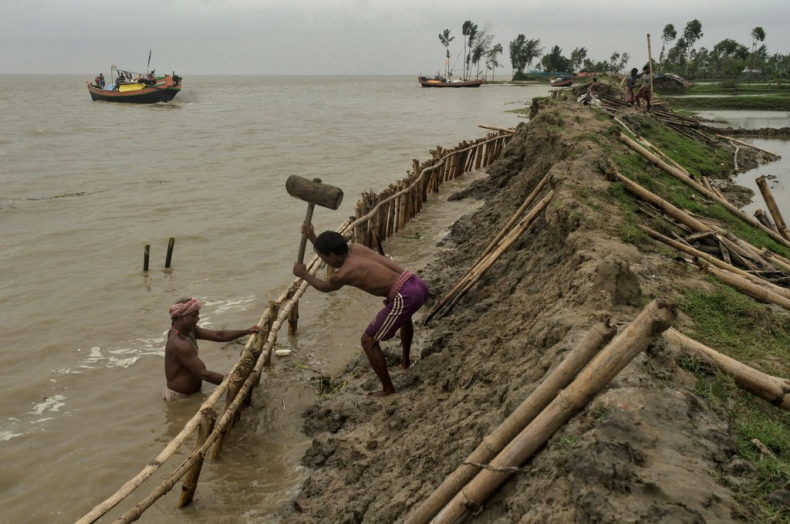On the eve of the last official negotiating day at COP26 in Glasgow, Scotland, vulnerable countries and environmental organizations asked rich countries to pay back what they promised more than a decade ago.
Compensating for developing countries to adapt to climate change, deal with the damage already done, and pay for a transition to a clean economy was a key commitment when 2015 Paris Agreement was signed. But the promise to deliver $ 100 billion annually by 2020 was broken and is not expected to be fulfilled until 2023 at the earliest, developed countries say.
Developing countries have said at the UN conference on climate change that they want to see more cash on the table, recognizing that trillions will be needed to fund the transition.
If the money comes in, it will help cover the cost of reducing greenhouse gas emissions, while also preparing for climate breakdown, known as mitigation and adaptation, respectively. But the countries most vulnerable to climate change also want the rich countries, which play a huge role in driving the crisis, to pay for the damages.
“Tuvalu is on the front lines of climate change. We experience climate change in our daily lives. We have our land rapidly disappearing and our islands are sinking, ”Tuvalu Finance Minister Seve Paeniu said during a press conference.
Paeniu said Tuvalu is generally only two meters above the high tide line, so the nation is effectively sinking and requires significant land reclamation, similar to a project. previously performed by the Maldives.
“There is proven technology, it has been done successfully and there is no other option for Tuvalu. We have to raise our land, ”he said.
What people are reading

Paeniu said one of the main concerns in Glasgow for vulnerable countries is simplifying access to promised climate finance to ensure that the most vulnerable can get what they need.
Germany and Canada were chosen earlier this year to help deliver the annual minimum of $ 100 billion pledged for climate finance. But all the two countries could do was a promise that the money would arrive in a few years.
the delivery plan is based on two scenarios considered by the Organization for Economic Cooperation and Development (OECD). You see $ 106 billion delivered by 2023 assuming countries and development banks fully meet their commitments. A second scenario, based on less private equity investment than previously assumed, would be $ 101 billion delivered by 2023.
“All of our farms are being wiped out, all of our livelihoods are being wiped out, all of our streams are being wiped out. So who pays for these damages? “Emmanuel Tachie-Obeng from Ghana tells # COP26. # COP26xCNO #compensation
Emmanuel Tachie-Obeng, chief program officer for the Ghana Environmental Protection Agency, echoed the call for rich countries to deliver on their promises, noting that climate collapse has arrived.
“All of our farms are being wiped out, all of our livelihoods are being wiped out, all of our streams are being wiped out. So who pays for these damages? ” he said.
“It’s very important that we have a loss and damage facility, (and) so all we’re saying is that we should have insurance,” he added.
Canada continues to work on its plans
Canadian Environment and Climate Change Minister Steven Guilbeault says Canada has been “actively involved” in loss and damage negotiations, but is not yet in a position to commit.
“Some (jurisdictions) may decide (to fund loss and damage) voluntarily, but the architecture of what it would look like is just not there,” he said, adding that that shouldn’t stop other governments from doing more.
Scotland, for example, promised £ 1 million in loss and damage on Monday.

Earlier this year, Canada Announced it would double its international climate finance from $ 2.65 billion to $ 5.3 billion over the next five years. It also said it would increase the amount of money awarded in grants from 30 percent to 40 percent, which equates to approximately $ 424 million to be awarded annually with no expectation of repayment.
“The next issue from Canada is a conversation that hasn’t started,” Guilbeault said. “We just doubled down a few months ago, but I agree that we need to do more.”
Canada Climate Action Network’s international climate diplomacy manager Eddy Perez says it’s good that Canada isn’t opposed to loss and damage financing, but says the government has changed its priorities.
“Sometimes when you ask a question about what we need to solve, they think about the end of the road and how bumpy it is, before they build the road,” he said.
It would be better for Canada to prioritize including loss and damage in discussions to keep the 1.5 C threshold within reach, Perez said.
“Canada should stop thinking like a developed country, like a financier… (because) right now that’s not the discussion. The discussion is … how much are you ready to step up? “Pérez said.
Loans increase poverty, says Ghana
Both Paeniu and Tachie-Obeng called for climate finance to be delivered in grants, rather than loans, to avoid predatory lending schemes that have historically held back developing countries.
“If you have loans, it will make us even poorer,” Tachie-Obenge said.
TO high-level statement released by the Marshall Islands on Thursday calls for a 50 percent split between mitigation and adaptation funding, and warned the G20, whose emissions make up the vast majority of global emissions, that “the world is watching.”
“We will never accept that anthropogenic climate change, which we do not cause, is the basis for the loss of our sovereignty, our sovereign rights or our maritime borders,” the statement read.
Reference-www.nationalobserver.com